Fujifilm FinePix Z900 EXR Review
Fujifilm FinePix Z900 EXR
Does the Fujifilm FinePix Z900 EXR offer the performance to go with its stylish good looks?
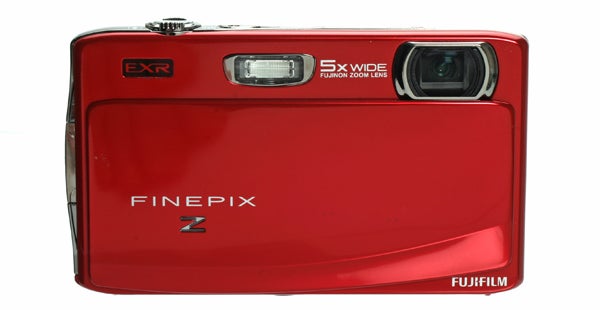
Verdict
Pros
- Solid construction
- Large display
- Intuitive touch-screen control
Cons
- Lens isn't the sharpest
- Slow to start up
- Poor battery life
Key Specifications
- Review Price: £200.00
- 16.2-megapixels
- 5x optical zoom
- Sensor-shift image stabilistion
- Panoramic mode
- 1080p Full HD movie recording
With a minimal number of physical buttons and a generous 3.5-inch touchscreen, the 16-megapixel Z900 will doubtless appeal to young, smartphone-savvy casual photographers looking for something a bit more substantial and advanced, that can outperform the built-in camera in their iPhone 4, Samsung Galaxy S2, Nokia N8 and suchlike.
On paper, the Z900 appears to have all the right attributes. It’s smart, stylish and packs plenty of resolution. Add to this some unique shooting modes, solid movie recording abilities and some interesting slow-motion capture modes and it’s easy to see its appeal. The big question is whether it all ties together into a neat, value-for-money package. As we’re rather fond of saying in these parts, let’s take a closer look and find out.
At its heart the Z900 uses a 1/1.2-inch backside-wired CMOS EXR sensor with an effective resolution of 16.2 megapixels. This represents a fairly substantial upgrade over the 12-megapixel Super CCD chip that was found in the Z800, and is a sure sign of the growing popularity of backside-wired CMOS sensors. 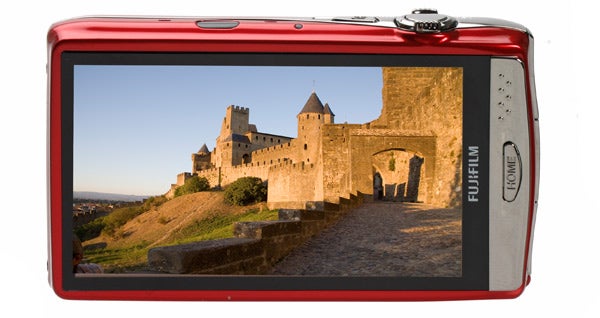
In fact, Fuji now uses exactly the same CMOS EXR sensor in all of its recent EXR models – including the recently reviewed Fujifillm HS20 superzoom and the Fujifilm F550 EXR advanced travel-compact. This EXR sensor uses a unique triple-layer pixel array that allows the sensor to optimise for resolution, sensitivity or dynamic range, depending on the scene it’s faced with.
The Z900’s EXR sensor is paired with Fujifilm’s own dual-core image
processor that allows the Z900 to shoot continuously at 3fps at the full
16MP right up to 12fps at 4MP. Sensitivity, meanwhile, stretches from
ISO 100 to 6400.
Still images can be recorded at a maximum of 4608 x 3456 pixels in the default 4:3 aspect, with further 4:3 options of 8MP and 4MP. Aside from this, the only other option is 16:9, which can be used up to a maximum resolution of 4608 x 2592 pixels. As might be expected the Z900 is JPEG only (no RAW options here), although compression can be set to either Fine or Normal quality.
The Z900 gets a 5x optical zoom that uses a folded-lens design, protected by a sliding front panel that also acts as the camera’s main on/off switch. In 35mm terms, this offers a focal range of 28-140mm. It’s by no means the widest on the market, although it should be enough to cover most day-to-day needs. Maximum aperture is not particularly fast ─ f/3.9 at 28mm, rising to f/4.9 at the telephoto end.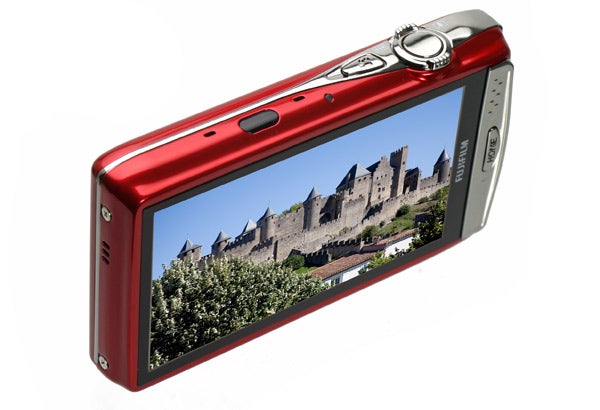
Shooting modes are very much of the point-and-shoot variety although to be fair, there is a good range on offer, including the three EXR-specific modes, each of which takes advantage of Fuji’s triple-layer sensor design in a different way. The first is a High Resolution mode for when maximum-sized images are the priority. The second, High ISO and Low Noise, offers better performance in low light, while the final option, Dymanic Range Priority, aims to retain as much shadow and highlight detail in high-contrast scenes as possible. If you’re unsure which one you should be using then the camera can be set to choose automatically.
Elsewhere there’s a new Automatic mode whereby the camera will automatically select an appropriate Scene mode, plus there are 15 individual Scene modes (collectively accessed via a single sub-menu, obviously), and a couple of Portrait specific modes whereby the Z900 can be ordered to shoot without flash, or to shoot both with and without in a single button press. The final shooting option is a Program mode that allows you some degree of control over basic shooting settings from White Balance to AF Mode and suchlike.
On top of all this there’s also a Panorama mode that allows you to make 120, 180 or even 360-degree panoramas simply by panning the camera in a predetermined direction with the shutter button held down. This is a lot of fun to use and the results are actually pretty good too.
The Z900 doesn’t offer any built-in digital filter effects to play around with, nor is there any way to tweak individual JPEG processing characteristics such as saturation and sharpness. You can however choose a Film Simulation profile, with the standard ‘Provia’ setting complemented by a more vivid ‘Velvia’ option. These names will undoubtedly sound familiar to old-school film photographers – they’re named after well-known 35mm film stock from Fujifilm. If only there was an ‘Astia’ slide-film option for muted portraits too. Oh well, you can’t have everything!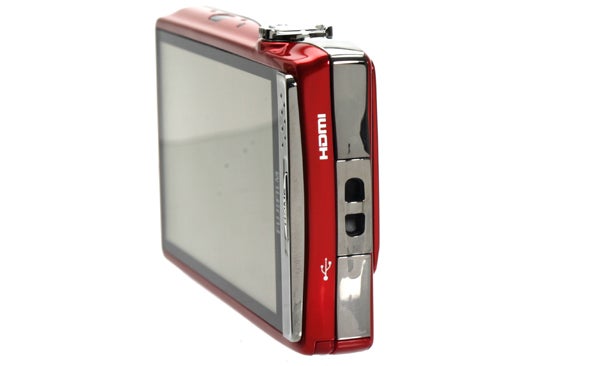
In addition there are three Dynamic Range settings – 100%, 200% and 400% – that, in theory, allow you to expand the Z900’s dynamic range beyond its default setting. In practice, however, we struggled to see how changing these settings made any great difference to high-contrast scenes.
Movies can be recorded at a maximum 1920 x 1080p Full HD at 30fps. And in keeping with other Fuji EXR models, the Z900 also offers some high-speed movie modes (albeit in reduced resolution) including 60fps and 120fps options
One further trick up the Z900’s sleeve worth a quick mention is the ability to upload your images directly to Facebook and YouTube. Although not exactly new to the Z900 we expect it’ll nonetheless prove popular with its target audience. You’ll need to install the software using the bundled disc to get it to work, mind.
With its primarily metal finish, the Z900 has a nice, solid feel to it. Our review sample came in a dark shade of ruby red, which to our eyes looks pretty classy. In terms of weight the Z900 hits a good sweet spot, being weighty enough to feel well-made yet light enough to carry around all day.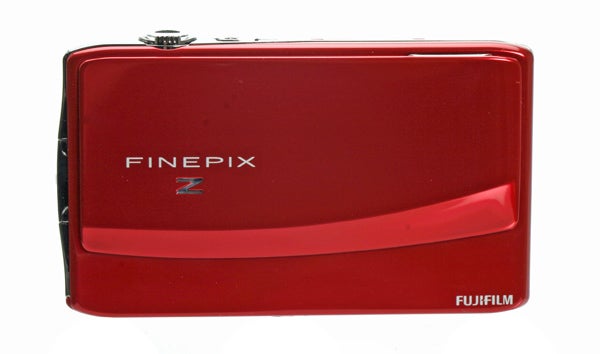
The sliding cover that protects the lens and acts as the main on/off switch offers just about enough resistance to avoid being accidentally opened inside a bag, while the sculpted edge adds to the overall finish. Given the sliding fascia design, a finger-grip was never really going to be possible and the Z900 does lose some points here for being a bit slippery in the hand – something that’s not especially helped by its smooth, shiny finish.
There are but four physical buttons on the Z900 – a shutter button, a zoom control, a one-touch movie record button and a Home button. Everything else is controlled via the 3.5-inch touchscreen. At 460k-dots the screen itself is plenty sharp enough and also remains quite easy to view in bright outdoors conditions.
Sensitivity of the touchscreen is very good, the camera recognising virtually all of our finger-jabbing commands first time. We did experience a bit of seizure on a couple of occasions, although it should be noted that at both times the camera had sustained some exceptionally prolonged use of the kind it’s unlikely to receive outside of a test environment.
In-camera menus have undergone a bit of a rejig. The Z900 now presents an icon-led top-level menu interface, rather like the camera app of an iPad or Android device. This makes navigating your way around the various in-camera menus a fairly painless experience.
Performance wise, the Z900 is a bit of a mixed bag. We timed the camera’s start-up time – from sliding the cover open to shooting a properly focused image – at about five and a half seconds. While we’ve yet to see a compact in this price bracket that offers anything even remotely approaching instant start-up-and-shoot abilities, five and a half seconds is undoubtedly slow.
Autofocus performance is better, at least in good light, with the Z900’s contrast-detect AF system able to lock on pretty much instantaneously. Speed remains pretty good in less than ideal light too, although in very dim to near dark situations the camera does struggle. This isn’t helped by the absence of an AF Assist light on the front of the camera either.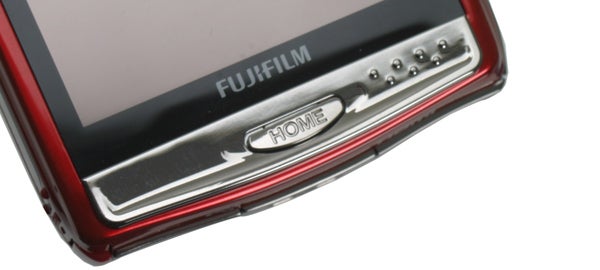
Used in Single-shot mode it’s possible to shoot at just under a frame a second, with no upper limit on the number of shots you can take. Switching over to Continuous mode the fastest speed at which you’ll be able to shoot along with the maximum number of shots you’ll be able to take is directly affected by the resolution you are shooting at.
For example, at 16MP it’s possible to shoot at 3fps albeit for a maximum three frames, after which you can expect to wait about five seconds while the camera processes the images. Drop the resolution down to 4MP though and you’ll be able to shoot at 12fps up to a maximum 12 frames, followed by about an eight-second processing wait. High-speed shooting (at lower resolutions) has long been a strength of Fujifilm compacts, and the Z900 follows this tradition.
One thing that does rather let the Z900 down is battery performance. The supplied 720mAh Li-Ion battery drains especially fast, especially if you are prone to changing settings often and using the camera to review your images. Used constantly like this, we were barely able to get three hours from the battery. Of course, if you’re just pulling the camera out to shoot the odd snap every once in a while this probably won’t be so much of an issue.
It’s now generally accepted that the digital camera industry has moved beyond the ‘megapixel wars’ that dominated marketing campaigns up until a few years ago. However, so many 16-megapixel compacts have been released recently it seems there is a case for re-iterating what’s already been said by us and countless other digital camera reviewers – we’d much prefer to see Fuji (and other manufacturers) peg the resolution of their 1/1.2-inch compact sensors to more manageable levels (about 10/12-megapixels is more than ample) and concentrate instead on other aspects of picture quality. 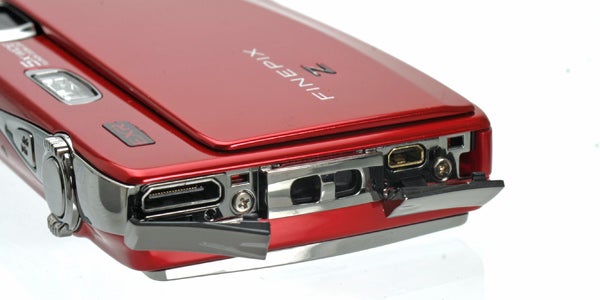
In other words, there’s not much point in being able to blow images up to poster-sized dimensions if all that does is reveal the effects of overzealous image processing, large-scale JPEG compression and noise reduction. Far better, surely, to reduce the physical size of prints and produce images that are smaller and more natural-looking?
This isn’t a criticism we’re levelling specifically at Fujifilm or the Z900 in particular, as all compacts tend to suffer from exactly the same problem to a greater or lesser degree. That said, when the Z900’s images are viewed at 100% and above they can be seen to suffer from the ‘smudged detail’ and ‘painted-on’ effects so common with small-sensor compacts.
It’s also worth noting that while the use of a folded-lens design does help to ensure that a camera is small and portable there is a trade-off in image quality, specifically a drop off in sharpness. That’s not to say that all images produced by the Z900 are inherently blurred, however the ‘strike rate’ for what we’d class as pin-sharp images is significantly lower – especially when the Z900’s zoom is extended deep into telephoto territory.
On the plus side, the Z900’s 256-zone TTL metering module is consistently accurate, producing images with good highlight retention, especially when the camera is being used in the EXR Auto or Dynamic Range-priority mode. 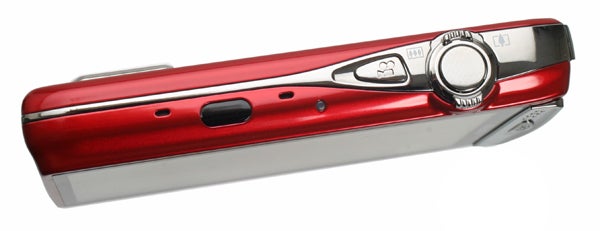
In fact, given that the EXR shooting modes are a big selling point of the Z900 we don’t mind admitting that we felt compelled to use them as much as possible. In doing so it quickly became clear that they produce images with much greater contrast and vibrancy than images shot in Program mode. See the Sample Images gallery for some visual examples of this.
If all of the above sounds a bit critical, rest assured that the Z900 is far from alone in not being perfect. The overwhelming majority of compacts on the market suffer from exactly the same problems to a lesser or greater extent. For the vast majority of day-to-day snappers the Z900 is capable of producing perfectly acceptable image quality.
Verdict
The Fujifilm FinePix Z900 EXR is a stylish little ultra-compact that feels solid and well made. The large 3.5in monitor is sharp and clear and remains useable outdoors in bright conditions too. The touchscreen controls are perfectly responsive and the new icon-based menu is easy to navigate. Overall, we’d say that image quality is on a par with other compacts in this price range. The EXR-specific shooting modes deliver plenty of contrast and also help to reduce noise in low-light conditions. The lens can be a bit soft though, especially at the edges and corners and at its telephoto extremes.

The full scene

This 100% crop shows how the Z900 produces a sharp(ish) and noise free image at the base ISO 100

ISO 200

ISO 400

ISO 800

ISO 1600

ISO 3200

ISO 6400
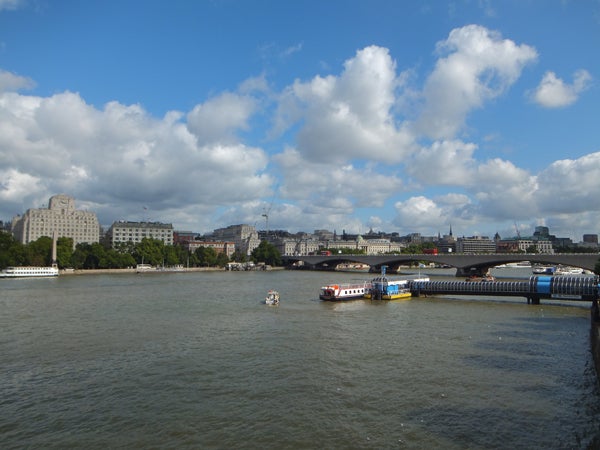
While 28mm isn’t the widest wideangle lens going, it still fits plenty in

This image clearly shows how, at its 140mm telephoto extreme, the Z900 lens is fairly soft

Images shot using the Z900’s three EXR shooting modes display plenty of contrast and snap

Whereas images shot in Program mode are far more muted and flat, and often shorn of highlight detail
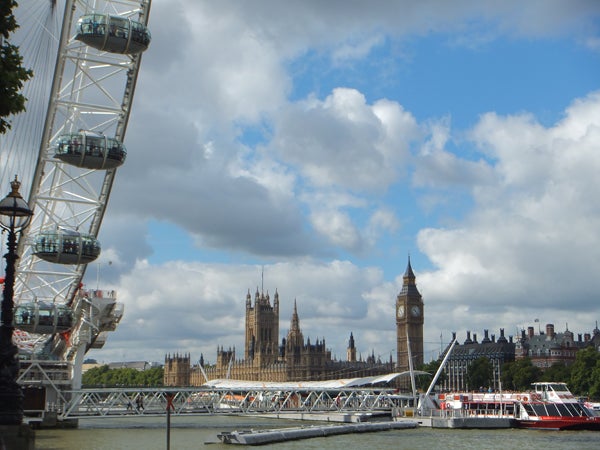
The Dynamic Range-priority EXR mode can produce lively images
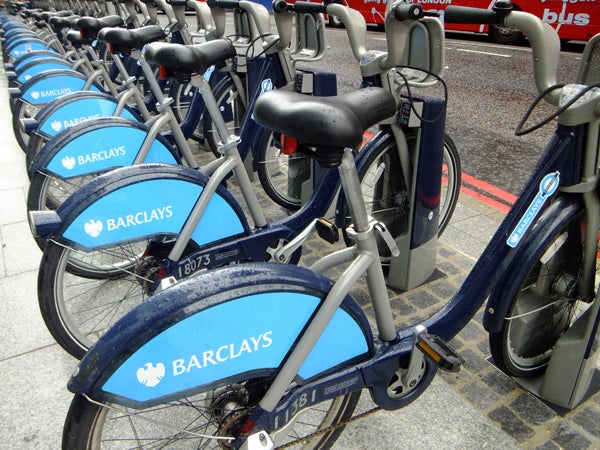
Again, here’s the EXR shooting mode delivering a fairly punchy image

The ‘Velvia’ Film Simulation setting mirrors Fuji’s vibrant 35mm film stock of the same name

This was originally shot in Program mode and came out a little flat, so we’ll admit to making a quick levels adjustment in Photoshop
Trusted Score
Score in detail
-
Value 8
-
Design & Features 7
-
Image Quality 7
-
Build Quality 8

